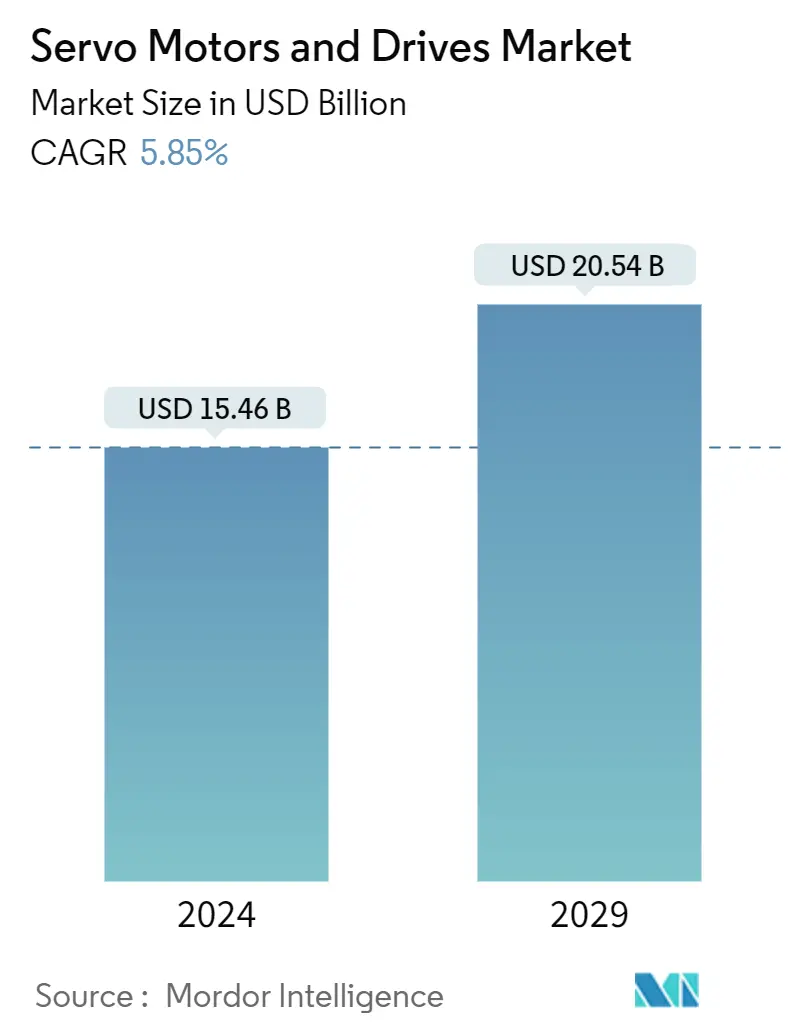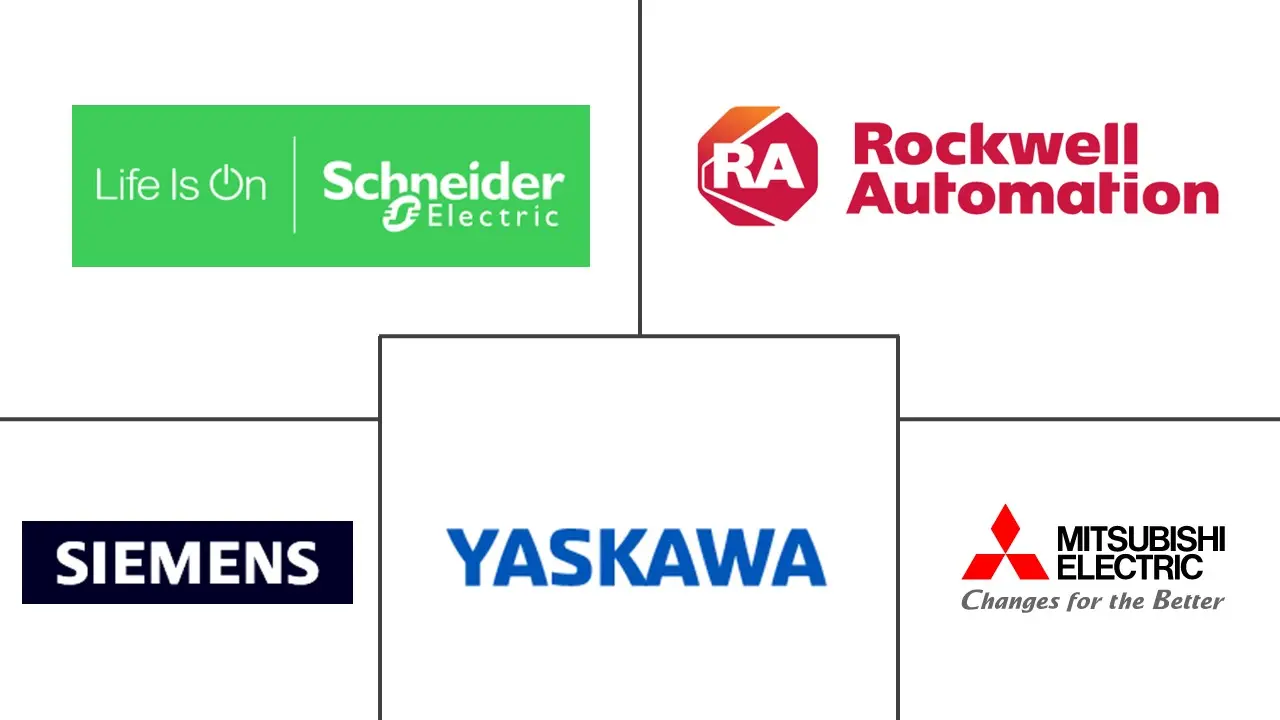Market Size of Servo Motors And Drives Industry

| Study Period | 2019-2029 |
| Market Size (2024) | USD 15.46 Billion |
| Market Size (2029) | USD 20.54 Billion |
| CAGR (2024 - 2029) | 5.85 % |
| Fastest Growing Market | Asia Pacific |
| Largest Market | Asia Pacific |
| Market Concentration | Low |
Major Players
*Disclaimer: Major Players sorted in no particular order |
Servo Motors And Drives Market Analysis
The Servo Motors And Drives Market size is estimated at USD 15.46 billion in 2024, and is expected to reach USD 20.54 billion by 2029, growing at a CAGR of 5.85% during the forecast period (2024-2029).
Servo motors are AC, DC, or linear motors with in-built positional feedback. These motors are used in closed-loop motion control systems where angular position, speed, and torque can be accurately controlled. Using permanent magnets enables the variation of the voltage and current between windings. A servo drive is an automatic device used with servo motors that provide the required voltage to the motor to correct any deviation from the commanded status, helping the motor achieve precise positioning.
- Flexibility in machine tool operations is one of the most significant benefits. In addition, servos replace traditional gears, belts, and pulleys to eliminate wear and failure problems typical with older technologies. Servos increase productivity, reliability, and machine throughput.
- The industrial sector is among the major consumers of servo motors and drives as they are highly suitable for use in different types of industries owing to their ability to provide precise motion control. As a result, due to a growing rate of industrialization, especially across emerging regions, the adoption rate of advanced solutions such as robotics and automated equipment is likely to be higher across these regions.
- There has been significant growth in the demand for energy-efficient solutions on a global scale in recent years. The growing environmental concern and rising consumer awareness are among the major factors influencing the demand for energy-efficient solutions. With these factors becoming more prevalent during the forecast period, it is expected to have a notable impact on the dynamics of the servo motors and drives market.
- One of the major substitutes for servo motors is the stepper motor. A stepper motor is an electromechanical device that converts electrical energy into mechanical energy. It is also a brushless synchronous motor that can divide one rotation into many steps. Motor position can be precisely controlled without a feedback mechanism if the motor is carefully sized for the application. A stepper motor is like a switched reluctance motor.
- The outbreak of COVID-19 had been a nightmare for industrialists, i.e., a manufacturing recession. A significant slowdown in the sales of servo motors and drives from China disrupted the supply chain across applications, such as equipment, packaging materials, ingredients, and other plant supplies. Steel is among the major raw materials used in servo motors. As a result of disruptions that occurred in the steel industry, especially during the initial phase of COVID-19, the production of servo motors was hampered. For instance, China is a major steel producer. Owing to the outbreak of the pandemic, steel production in the country was hampered by trade restrictions, widespread lockdowns, and factory closures owing to restrictions imposed by the Republic of China's government during the pandemic.
- The COVID-19 pandemic increased the demand for semiconductors across the consumer electronics and automotive sectors, mainly due to the growing adoption of EVs post-pandemic. According to the Semiconductor Industry Association, in FY 2022, global semiconductor sales reached USD 574 billion, with total sales of US semiconductor companies at USD 275 billion, accounting for 48% of the global market. Moreover, worldwide sales of semiconductors totaled USD 134.7 billion during the third quarter of 2023, an increase of 6.3% compared to the second quarter of 2023.
Servo Motors And Drives Industry Segmentation
A servo motor is a simple electric motor that is controlled by a servomechanism. When a motor is used as a control device and is connected to a servomechanism, it is referred to as a DC Servo Motor. A controlled motor powered by AC is referred to as an AC Servo Motor. A servo drive is one of the fundamental components of a motion control system, which includes a servo motor, controller, and feedback element. Servo drives use closed-loop feedback to alter the voltage and current applied to the servomotor in response to a command signal for the position, velocity, or current.
The study tracks the revenue accrued through the sale of Servo Motors and Drives by various players in the global market. The study also tracks the key market parameters, underlying growth influencers, and major vendors operating in the industry, which supports the market estimations and growth rates over the forecast period. The study further analyzes the overall impact of COVID-19 aftereffects and other macroeconomic factors on the market. The report’s scope encompasses market sizing and forecasts for the various market segments.
The servo motors and drives market is segmented by type (motor [AC servo motor, DC brushlesss servo motor, brushed DC servo motor, and linear servo motor], drive [AC servo drive, DC servo drive, and adjustable servo drive]), voltage range (low voltage, medium voltage, and high voltage), end-user industry (automotive, oil and gas, healthcare, packaging, semiconductor and electronics, and chemicals and petrochemicals), and by geography (North America [United States, Canada], Europe [United Kingdom, Germany, France, and Rest of Europe], Asia-Pacific [China, Japan, India, South Korea, and Rest of Asia Pacific], Latin America, and Middle East and Africa). The market sizes and forecasts are provided in terms of value in USD for all the segments.
| By Type | ||||||
| ||||||
|
| By Voltage Range | |
| Low Voltage | |
| Medium Voltage | |
| High Voltage |
| By End-user Industry | |
| Automotive | |
| Oil and Gas | |
| Healthcare | |
| Packaging | |
| Semiconductor and Electronics | |
| Chemicals and Petrochemicals | |
| Other End-user Industries |
| By Geography | |||||||
| |||||||
| |||||||
| |||||||
| Latin America | |||||||
| Middle East and Africa |
Servo Motors And Drives Market Size Summary
The servo motors and drives market is poised for significant growth, driven by the increasing demand for precise motion control in various industries. These components, which include AC, DC, and linear motors with built-in positional feedback, are integral to closed-loop motion control systems, offering enhanced productivity, reliability, and machine throughput. The industrial sector, particularly in emerging regions, is a major consumer due to the rising rate of industrialization and the adoption of advanced solutions like robotics and automation. The push for energy-efficient solutions, fueled by environmental concerns and consumer awareness, is also shaping market dynamics. Despite challenges such as the COVID-19 pandemic, which disrupted supply chains and steel production, the market is recovering and expanding, particularly in the Asia-Pacific region, where countries like China and Japan are leading in industrial automation and robotics.
In the automotive industry, the demand for servo motors and drives is increasing due to their critical role in enhancing vehicle performance and safety through precise control of systems like power steering, throttle control, and brake systems. The integration of automation, digitalization, and AI in manufacturing processes is further propelling this demand, with robots becoming integral to assembly lines, improving productivity and reducing costs. The market is characterized by fragmentation, with major players like Yaskawa Electric Corp., Mitsubishi Electric Corp., and Siemens AG adopting strategies such as partnerships and product expansions to maintain a competitive edge. Recent developments, such as the expansion of product lines and the introduction of energy-efficient technologies, underscore the ongoing innovation and strategic initiatives within the market, positioning it for continued growth and transformation.
Servo Motors And Drives Market Size - Table of Contents
-
1. MARKET INSIGHTS
-
1.1 Market Overview
-
1.2 Industry Attractiveness - Porter's Five Forces Analysis
-
1.2.1 Bargaining Power of Suppliers
-
1.2.2 Bargaining Power of Buyers
-
1.2.3 Threat of New Entrants
-
1.2.4 Threat of Substitutes
-
1.2.5 Intensity of Competitive Rivalry
-
-
1.3 Industry Value Chain Analysis
-
1.4 Impact of COVID-19 Aftereffects and Other Macroeconomic Factors on the Market
-
-
2. MARKET SEGMENTATION
-
2.1 By Type
-
2.1.1 Motor
-
2.1.1.1 AC Servo Motor
-
2.1.1.2 DC Brushless Servo Motor
-
2.1.1.3 Brushed DC Servo Motor
-
2.1.1.4 Linear Servo Motor
-
-
2.1.2 Drive
-
2.1.2.1 AC Servo Drive
-
2.1.2.2 DC Servo Drive
-
2.1.2.3 Adjustable Servo Drive
-
2.1.2.4 Other Types of Drives
-
-
-
2.2 By Voltage Range
-
2.2.1 Low Voltage
-
2.2.2 Medium Voltage
-
2.2.3 High Voltage
-
-
2.3 By End-user Industry
-
2.3.1 Automotive
-
2.3.2 Oil and Gas
-
2.3.3 Healthcare
-
2.3.4 Packaging
-
2.3.5 Semiconductor and Electronics
-
2.3.6 Chemicals and Petrochemicals
-
2.3.7 Other End-user Industries
-
-
2.4 By Geography
-
2.4.1 North America
-
2.4.1.1 United States
-
2.4.1.2 Canada
-
-
2.4.2 Europe
-
2.4.2.1 United Kingdom
-
2.4.2.2 Germany
-
2.4.2.3 France
-
2.4.2.4 Rest of Europe
-
-
2.4.3 Asia-Pacific
-
2.4.3.1 China
-
2.4.3.2 Japan
-
2.4.3.3 India
-
2.4.3.4 South Korea
-
2.4.3.5 Rest of Asia-Pacific
-
-
2.4.4 Latin America
-
2.4.5 Middle East and Africa
-
-
Servo Motors And Drives Market Size FAQs
How big is the Servo Motors And Drives Market?
The Servo Motors And Drives Market size is expected to reach USD 15.46 billion in 2024 and grow at a CAGR of 5.85% to reach USD 20.54 billion by 2029.
What is the current Servo Motors And Drives Market size?
In 2024, the Servo Motors And Drives Market size is expected to reach USD 15.46 billion.

